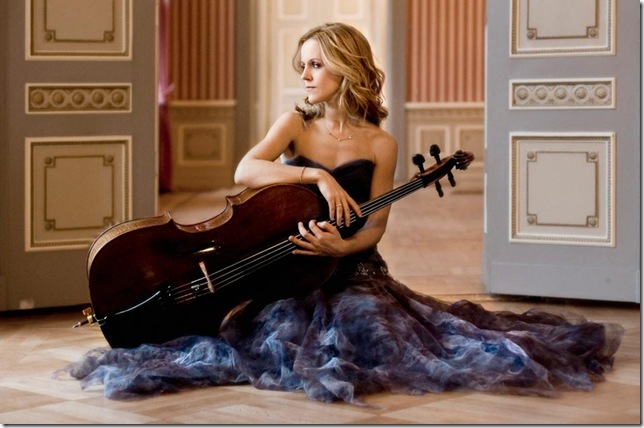If Sol Gabetta had done nothing else besides come out and play her concerto, the young Argentine cellist might have attracted additional attention for the balletic, kinetic way she moved behind her cello, or the way she smiled and nodded her head along with the music during the moments she wasn’t playing.
But Gabetta also came out and did a fascinating encore, and with that, she helped create an atmosphere of expectation and adventurousness that served the cause of the works she played and prepared the way for a fresh reading of a well-loved late Romantic symphony.
Gabetta appeared Wednesday night at the Kravis Center with the Detroit Symphony Orchestra under Leonard Slatkin, one of a handful of conductors at American orchestras who can be relied on to program outside the norm (much like his predecessor in Detroit, the Estonian-born Neeme Järvi). She played a too-rarely heard gem of American composition, the Cello Concerto (Op. 22) of Samuel Barber, whose birth centenary is being celebrated this year in classical circles.
Barber’s Cello Concerto isn’t quite as accessible as his Violin Concerto, but in its own way it is just as moving, and if only for its sheer craftsmanship and exceptional level of good taste it should by rights be a staple of symphonic programs, certainly in its own country.
And Gabetta is a fine cellist, a musician of thorough technique and interpretive sensitivity whose sound is intense and whose approach is nimble. She made a persuasive advocate for this concerto, even playing with extraordinary softness in some parts of the work, an effect that kept her audience interested.
Slatkin and the Detroit gave the work a passionate but controlled reading, and worked well with Gabetta, who occasionally referred to the sheet music. She handled the huge difficulties of the first movement, including aggressive chains of double and triple stops, with confidence and accuracy while staying alive enough to Barber’s lyric side to sing out the direct melodic passages.
In the Andante sostenuto, which featured some lovely oboe playing, Gabetta’s performance was heartfelt and beautiful, exemplifying the rapt, meditative mood Barber brought to so many of his formal slow movements. The exuberant but knotty finale contains much virtuoso display, and Gabetta added to her solid execution of those difficulties a rhythmic drive that gave the music a ferocious kind of interior energy.
Gabetta followed the concerto with a solo work by the contemporary Latvian composer Pēteris Vasks (b. 1946). Dolcissimo, which comes from Vasks’ 1978 Book for Cello, starts with whispers and astringent chords, then unfolds into a beautiful, melancholy lament in which the soloist is asked to sing wordlessly along with what she is playing. It was an exceptional effect: For a second, one didn’t know where this pretty, haunting voice was coming from. It was a fine piece of contemporary music-making, and welcome.
The Vasks closed the first half of the concert, which had begun with a boisterous, engaging rendition of Berlioz’s 1845 overture, Le Corsaire (Op. 21). The second half was devoted to the Symphony No. 2 (in E minor, Op. 27) of Rachmaninov.
The Rachmaninov can be an overlong experience in the concert hall, not just for its original length but because its very memorable melodies encourage orchestras and conductors to milk parts such as the slow movement for all they’re worth. But the best thing about this Rachmaninov was Slatkin’s feeling for its rhythmic life; here was a Rachmaninov that was lively and vivid rather than too plush for its own good.
If the brasses at the beginning of the symphony’s first movement were not as precisely in tune as they could have been, there was the compensation of the rich, full string sound and a lightness, a bounce, to the faster motifs that made it move. Good horn playing stood out in the second movement, and in the warm contrasting theme, the violins played with a judicious use of portamento, in keeping with the performance practice in place when the symphony was premiered in 1908.
Lovingly played clarinet, horn and violin solos in the slow movement added distinction to a well-played but not overly sentimental reading of this very familiar music, and the finale was notable for its swift tempo and rhythmic force, as well as an emphasis on coloristic effects such as a fierce passage for stopped horns.
Slatkin told the audience he wasn’t going to tell them the name of the encore on the grounds that it was too familiar, then led the Detroiters in a powerful version of the Farandole from Georges Bizet’s incidental music for Daudet’s L’Arlesienne.
The Detroit Symphony Orchestra, joined by soloist Sol Gabetta, repeats this program at 4 p.m. Sunday at the Adrienne Arsht Center in downtown Miami. Tickets are $50-$125. Call 305-949-6722 or visit www.arshtcenter.org.
